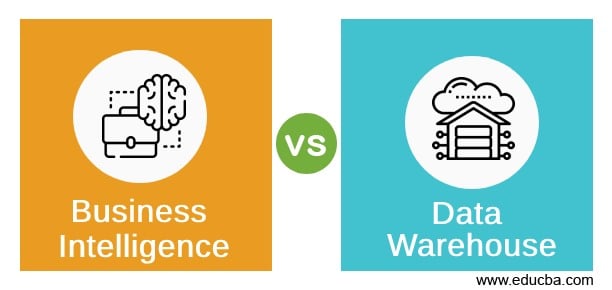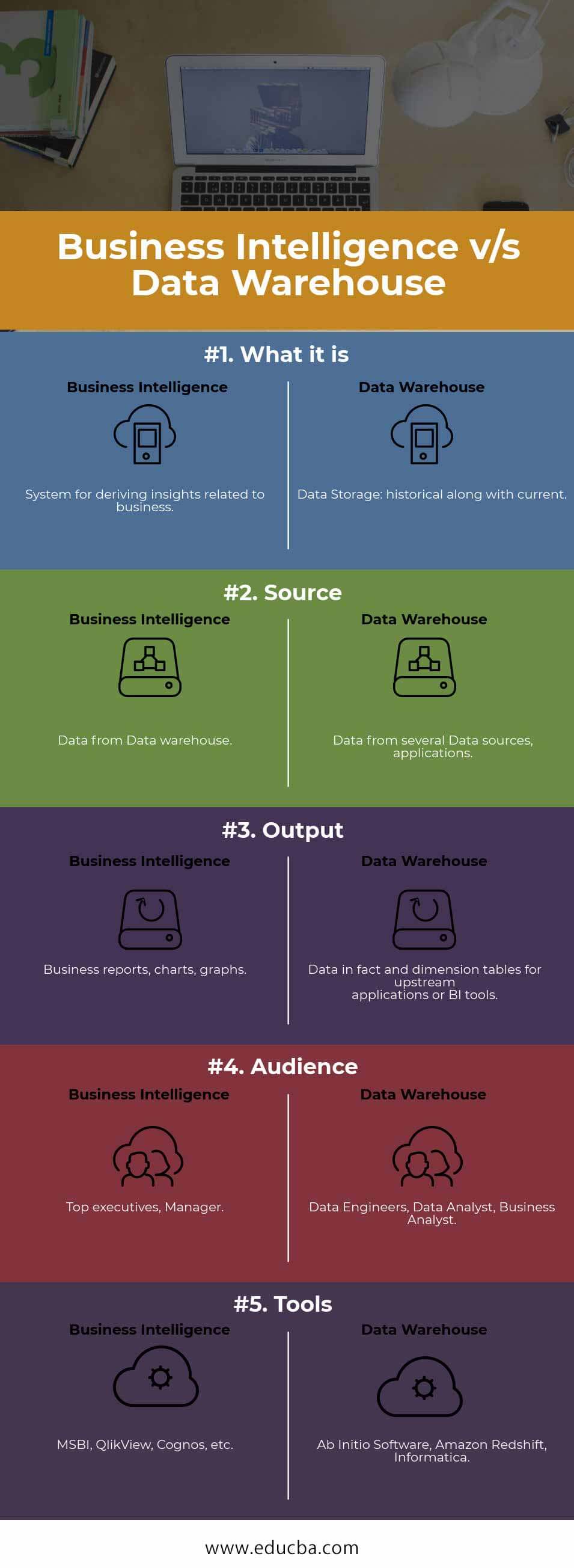Updated April 27, 2023
Difference Between Business Intelligence vs Data Warehouse
Business Intelligence (BI) is a set of methods and tools organizations use to access and explore data from diverse source systems to understand better how the business is performing and make a better-informed decision that improves performance and creates new strategic opportunities for growth.
Data Warehouse (DW) is simply a consolidation of data from various sources that set a foundation for Business Intelligence, which helps in making better strategic and tactical decisions. So I can say Data Warehouses have business meaning baked into them. Database stores data from different sources in a common format, and The Warehouse is like Godown (Big Building), where many things may be stored. Still, Data- Warehouse works with intelligent algorithms like Indexing, which helps locate and retrieve easily and on the same concept.
Data Warehouse is similar to a relational database aimed at querying and analyzing the data rather than for transaction processing. It usually contains historical data derived from transaction data but can include data from various sources. Data Warehouses hold data, in fact, Tables (Tables that cover numbers such as revenue and Costs) and Dimensions (Group Facts by different attributes like region, office, or week).
I will use certain abbreviations like BI for Business Intelligence and DW for Data Warehouse, as it’s easy to write. So far, I hope you have got enough understanding about both Business Intelligence and Data Warehouse concepts which are so commonly used in the Data Analytics Domain. These are so mistakenly used that even people in this domain are unsure what and when to use them.
Now let’s understand exactly what business intelligence is, which has created so much confusion in the Analytics industry as some people use both terms interchangeably. Lots of discussions are going on the internet.
A Business Intelligence system tells you what happened or is happening in your business; it describes the situation to you. Also, a good BI platform represents this to you in real time in a granular, accurate, and presentable form.
But on what basis it can do so? What is the source? How can it help me in taking a strategic decision?
I will tell you why it is so intelligent; using Data is simple. Data is accumulated over a significant amount of time from several disparate sources.
But now, a fundamental question arises about where this data is. This data is stored in the Data Warehouse (DDS, Cubes). And BI systems use Data Warehouse data and let you apply chosen metrics to potentially massive, unstructured data sets and cover querying, data mining, online analytical processing (OLAP), reporting, and business performance monitoring predictive and prescriptive analytics.
So now let’s compare Business Intelligence and Data Warehouse to better understand by comparing.
Head-to-Head Comparison Between Business Intelligence vs Data Warehouse (Infographics)
Below are the top 5 comparisons between Business Intelligence vs Data Warehouse:
Key Differences Between Business Intelligence vs Data Warehouse
Following are the differences between Business Intelligence vs Data Warehouse:
- BI means finding insights that portray a business’s current picture (How and What) by leveraging data from the Data Warehouse (DW).
- BI is about accessing and exploring an organization’s data, while Data Warehouse is about gathering, transforming, and storing data.
- DW outlines the actual Database creation and integration process along with Data Profiling and Business validation rules. At the same time, Business Intelligence uses tools and techniques that focus on counts, statistics, and visualization to improve business performance.
- BI deals with OLAP, data visualization, data mining, and query/reporting tools. In contrast, DW deals with data acquisition, metadata management, data cleansing, data transformation, data distribution, and data recovery/backup planning.
- DW teams use tools like Ab Initio Software, Amazon Redshift, Informatica, etc., while BI teams use tools like Cognos, MSBI, Oracle BI, Pentaho, QlikView, etc.
- Software engineers, mainly Data Engineers, deal with DW, while top executives, Managers deal with BI.
Business Intelligence vs Data Warehouse Comparison Table
Below is the comparison table between Business Intelligence vs Data Warehouse.
| Basis for Comparison | Business Intelligence | Data Warehouse |
| What it is | System for deriving insights related to business. | Data Storage: historical along with the current. |
| Source | Data from Data warehouse. | Data from several Data sources and applications. |
| Output | Business reports, charts, graphs. | Data, in fact, and dimension tables for upstream applications or BI tools. |
| Audience | Top executives, Manager | Data Engineers, Data Analysts, and Business Analysts. |
| Tools | MSBI, QlikView, Cognos, etc. | Ab Initio Software, Amazon Redshift, Informatica. |
Conclusion
So I finally want to conclude this article as BI tools like QlikView, MSBI, and Oracle BI all access data from Data Warehouses. And let business users create more granular and presentable reports, graphs, and charts, which help top executives to make more effective business decisions in different functional areas like finance, supply chain, human resources, sales & marketing, and customer service.
I want to put more light on this as nowadays, for Analytics, we are moving towards Big Data Ecosystem to handle a large amount of data, but yes, anyway, we are moving towards Enterprise Data Hub with distributed system and Map Reduce processing or in-memory execution engine like Spark. Now I hope it has made a clear distinction between Business Intelligence and Data Warehouse, and let me know your thoughts using the comment section.
Recommended Articles
This is a guide to Business Intelligence vs Data Warehouse. Here we have discussed head-to-head comparison, key differences, and a comparison table. You may also look at the following articles to learn more –




